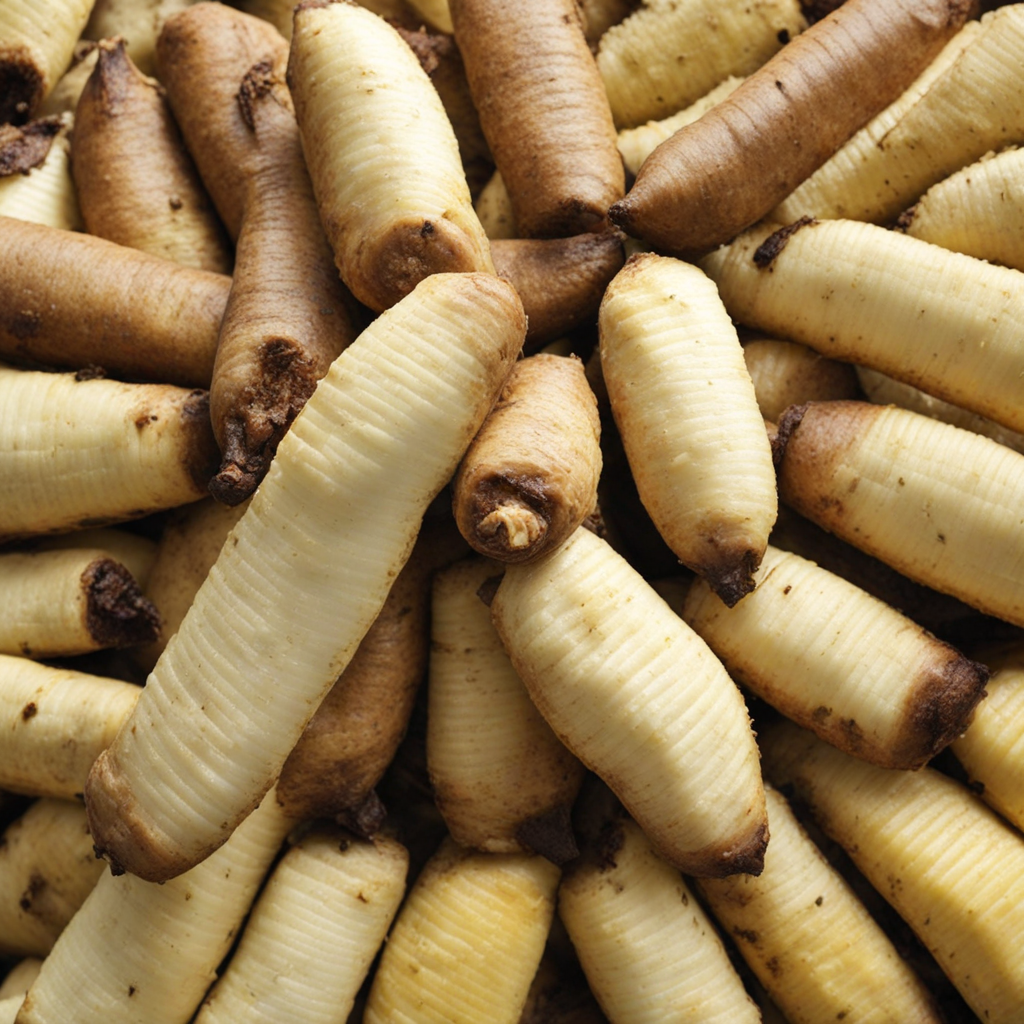Imigati
Imigati, a traditional Rwandan dish, showcases the rich agricultural heritage and culinary practices of the region. This delightful food primarily consists of cassava flour, which is kneaded and formed into a dough-like consistency. The dough is then molded into small, oval shapes and typically steamed or boiled until it achieves a soft, chewy texture. This versatility allows Imigati to be enjoyed in various ways, whether as a side dish or as a base for other ingredients, making it a staple in many Rwandan households. What makes Imigati particularly special is its ability to absorb flavors beautifully. It is often served alongside flavorful sauces, such as those made from beans, vegetables, or meat, allowing the dish to take on the essence of the accompanying ingredients. The subtle nutty taste of cassava flour combined with the savory or spicy sauces creates a harmonious balance that tantalizes the palate. Many enjoy Imigati with a side of fresh vegetables, enhancing the nutritional value and adding a refreshing crunch to the meal. As you delve into the experience of tasting Imigati, you'll find it represents more than just food; it embodies the spirit of Rwandan culture and community. Sharing this dish with friends and family is a common practice, fostering connections and conversations around the table. Whether you choose to enjoy it with a traditional Rwandan sauce or alongside grilled meats, Imigati promises to introduce you to a unique flavor profile that is both comforting and deeply rooted in the heart of Rwandan cuisine.
How It Became This Dish
Imigati: The Heart of Rwandan Culinary Heritage Imigati, a traditional Rwandan dish, is a food deeply woven into the fabric of Rwandan culture, history, and community life. This delightful dish, primarily made from cassava flour, is a staple in Rwandan households and serves not only as a source of nourishment but also as a symbol of resilience, unity, and identity. Origins of Imigati The roots of imigati can be traced back to the ancient agricultural practices of the Bantu-speaking peoples who first settled in the region that is now Rwanda. Cassava, a drought-resistant root vegetable, was introduced to Africa from South America via the transatlantic slave trade and became a significant crop due to its adaptability to various climates and soils. In Rwanda, where the highland terrain and varying altitudes posed challenges for agriculture, cassava thrived, quickly becoming a primary food source. The preparation of imigati involves mixing cassava flour with water to create a dough, which is then shaped and boiled. This method of preparation reflects the resourcefulness of Rwandan communities, who learned to make the most of locally available ingredients. Over generations, the recipe for imigati has been passed down through families, each adding their unique touch, making it a dish rich in personal and communal history. Cultural Significance Imigati holds significant cultural importance in Rwanda. It is more than just a food item; it is a symbol of hospitality and togetherness. Traditionally, it is served during communal gatherings, celebrations, and ceremonies, including weddings and funerals, signifying the importance of sharing meals as a way of strengthening community bonds. In Rwandan culture, food is intricately tied to social values. The act of preparing and sharing imigati fosters connections among family and friends. It is often accompanied by a variety of sauces made from vegetables, beans, or meat, transforming it into a wholesome meal that brings people together. The communal aspect of eating imigati emphasizes the values of unity and cooperation, which are especially significant in a country that has experienced profound social upheaval. The dish also plays a role in the Rwandan cultural narrative. Following the 1994 genocide, which left deep scars on the nation's psyche and social fabric, imigati became a symbol of resilience. As communities began to rebuild, sharing meals, particularly imigati, helped foster dialogue and healing among individuals from different backgrounds. This connection through food serves as a reminder of the strength of Rwandan identity and the importance of coming together in times of hardship. Development Over Time Throughout the years, imigati has evolved while still holding on to its traditional roots. The introduction of modern cooking techniques and globalization has influenced how imigati is prepared and consumed. While the traditional method of hand-mixing cassava flour and water remains popular, some Rwandans have adopted more contemporary cooking appliances to streamline the process. Moreover, the growth of urbanization has changed the dynamics of food consumption in Rwanda. In urban centers, where people often have less time to prepare traditional meals, pre-packaged ingredients and instant versions of imigati have emerged. However, this modernization has not diminished the dish's cultural significance. Instead, it has led to a greater appreciation for traditional cooking methods as people seek to reconnect with their heritage. The global interest in African cuisine has also brought imigati into the spotlight. Rwandan restaurants and chefs have started to explore and innovate with imigati, incorporating it into fusion dishes that appeal to a broader audience. This has sparked a culinary dialogue, allowing imigati to be recognized not just as a traditional food but as a versatile ingredient that can adapt to various culinary styles. Imigati in Contemporary Rwandan Society Today, imigati continues to be a beloved dish in Rwanda, cherished by both the older generations who grew up with it and the younger generations who are discovering its richness. It is often featured in Rwandan homes, restaurants, and even at international food festivals, where it showcases the depth of Rwandan cuisine. The resurgence of interest in traditional foods, fueled by movements towards sustainable and healthy eating, has positioned imigati as a nutritious option. Its main ingredient, cassava, is gluten-free and rich in carbohydrates, making it an excellent source of energy. This aligns well with global trends that favor whole foods and traditional diets, further enhancing the dish's relevance in today's health-conscious society. In addition, various initiatives aimed at promoting local agriculture have highlighted the importance of cassava cultivation. Farmers are encouraged to grow cassava not only for local consumption but also for export, as it is a valuable cash crop. This focus on local ingredients not only boosts the economy but also ensures that traditional dishes like imigati remain at the forefront of Rwandan cuisine. Conclusion Imigati is more than just a dish; it is a culinary emblem of Rwanda's rich history and cultural identity. From its origins rooted in the fertile soils of the Rwandan highlands to its contemporary role in fostering community unity and resilience, imigati represents the enduring spirit of the Rwandan people. As it continues to evolve, embracing modern influences while maintaining its traditional essence, imigati stands as a testament to the power of food in shaping cultural narratives and preserving heritage. In every bite, one can taste the history, the struggles, and the triumphs of a nation that has come to define itself through its culinary practices, making imigati a true cornerstone of Rwandan life.
You may like
Discover local flavors from Rwanda







